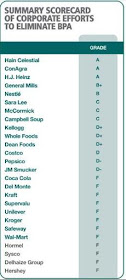BPA leaches because the ingredients used in producing polycarbonates and epoxy resins are just loosely bound enough that they break down under heat or when damaged.
Seven U.S. states have banned BPA in some products ( infant products, specifically - Connecticut, Minnesota, Maryland, Massachusetts, New York Wisconsin, Vermont, and Washington State ) , Denmark and France have restricted it, Canada designates it a "toxic chemical," and Germany warns consumers to avoid it. I found this list online, and was quite taken aback by the number of large food companies that still use BPA in packaging. To be fair - most companies do have plans to phase out BPA. However, most have set the phase out date far in the future - some as late as 2020.
I found this helpful visual over at Rubbermaid to be of use. Nice to see a company pointing out exactly which products they make are BPA Free.
The U.S. Food and Drug Administration has expressed "some concern" about BPA's potential effects on the brain, behavior and prostate gland of fetuses, infants and young children but has not banned it. Specifically, scientists believe BPA consumption especially among women of child bear age is strongly cautioned - the effects of BPA are cumulative, and perinatal exposure to BPA has significant risks to the unborn child.
How are recyclable plastics marked?
In general, plastics that are marked with recycle codes 1, 2, 4, 5, and 6 are very unlikely to contain BPA. Some, but not all, plastics that are marked with recycle codes 3 or 7 may be made with BPA.
Why is this connected with Clean Eating? Clean Eaters try to eliminate unnatural things from our consumption - and quite clearly, BPA is one we can easily avoid if we take some common sense steps and make a few key swap outs. Most of us have a plastic water bottle within arm's reach at all times. That bottle must be BPA Free.
If you're concerned about exposure to BPA, follow these simple suggestions from the National Institute of Environmental Health Sciences:
- Don’t microwave polycarbonate plastic food containers. (Look for the recycling symbol #7 on the bottom.)
- Reduce your use of canned foods over all
- When possible, opt for glass, porcelain or stainless steel containers, particularly for hot food or liquids.
- Use baby bottles and toys that are BPA-free.



